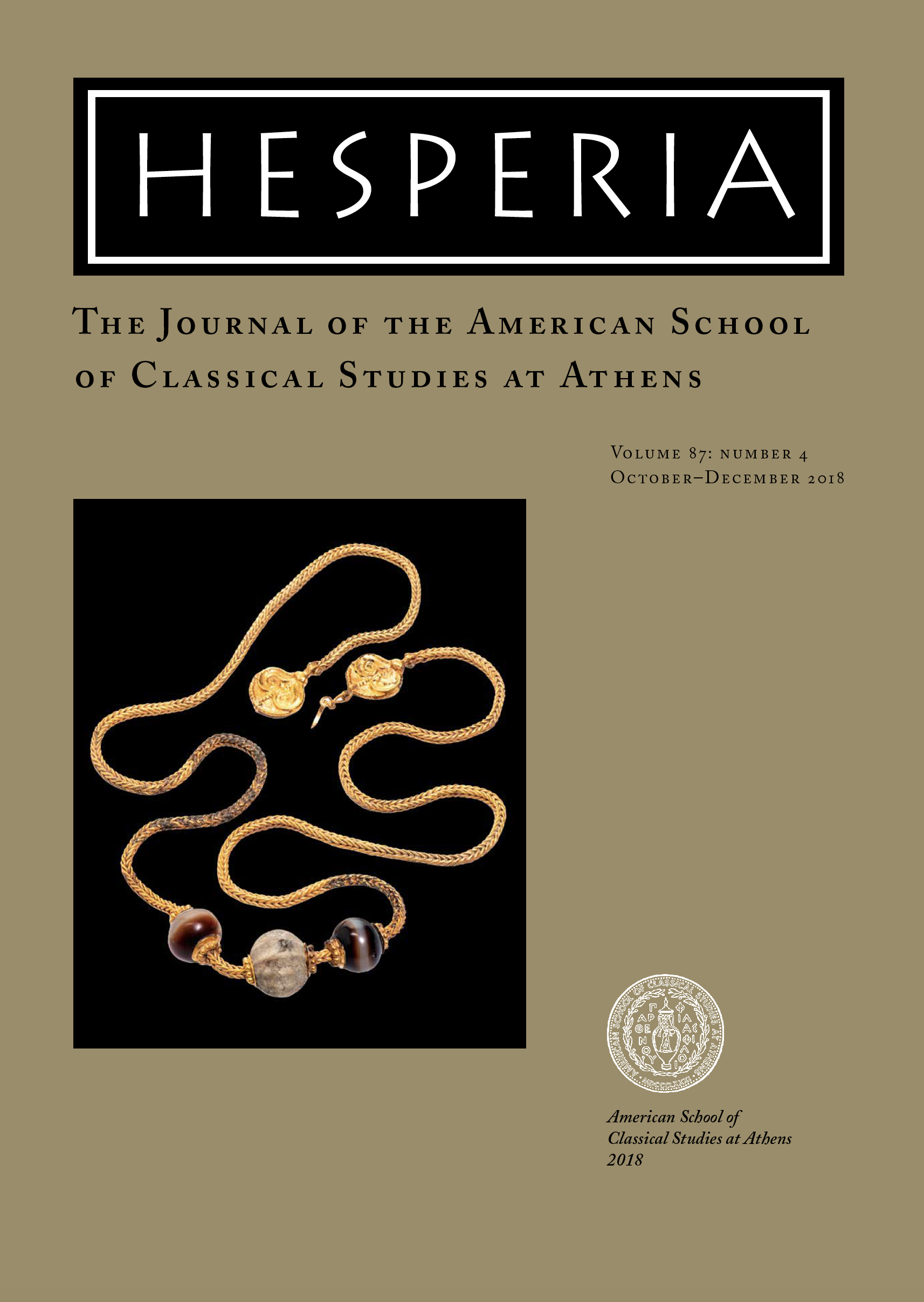Hesperia 87.4 Now Online!
 The American School of Classical Studies at Athens is pleased to announce the publication of Hesperia 87.4. Topics in this issue include the presentation of a gold necklace from the Late Helladic grave of the Griffin Warrior at Pylos; a reexamination of a Protoattic votive deposit from the Athenian Agora; a study of the akroteria and pedimental sculptures belonging to the Hephaisteion; and a look at the scholarly significance of Sir John Beazley’s research notebooks for the study of Athenian figured pottery.
The American School of Classical Studies at Athens is pleased to announce the publication of Hesperia 87.4. Topics in this issue include the presentation of a gold necklace from the Late Helladic grave of the Griffin Warrior at Pylos; a reexamination of a Protoattic votive deposit from the Athenian Agora; a study of the akroteria and pedimental sculptures belonging to the Hephaisteion; and a look at the scholarly significance of Sir John Beazley’s research notebooks for the study of Athenian figured pottery.
Subscribers can read the issue online at JSTOR, which now hosts all current issues of Hesperia as well as an archive of past volumes. The printed version will be mailed shortly.
The Gold Necklace from the Grave of the Griffin Warrior at Pylos, by Jack L. Davis and Sharon R. Stocker, presents an elaborate gold necklace with two beads of agate and one of faience that was among the hundreds of precious artifacts found within the Late Helladic II burial of the so-called Griffin Warrior, discovered at Pylos in 2015, which yielded hundreds of precious artifacts. Through detailed study, the authors argue that it is of Minoan manufacture, and they suggest that it had been worn as a badge of honor by warriors. Detailed chemical analyses of the the central bead appear in an attached appendix and support its identification as faience.
Figurines in the Road: A Protoattic Votive Deposit from the Athenian Agora Reexamined, by Michael Laughy, focuses on a large Protoattic votive deposit located near the southwest corner of the Athenian Agora. Originally published by Dorothy Burr in 1933, the deposit includes a number of terracotta votive shields, horses, and chariots, as well as a remarkably well-preserved terracotta plaque depicting a “Mistress of Snakes.” While there has long been a consensus among archaeologists that this votive assemblage is indicative of a cult of the dead, the author’s detailed reexamination of the deposit and its context concludes that the votives were dedications to Demeter that came from the Eleusinion.
Classical Sculpture from the Athenian Agora, Part 1: The Pediments and Akroteria of the Hephaisteion, by Andrew Stewart, attributes 25 fragmentary sculptures from the Agora excavations to the pediments and akroteria of the Hephaisteion on the basis of their compatibility with the akroterion bases and the sockets in the pediment floors, and their poses, identities, findspots, marble, scales, weathering, styles, and technique. The pediments are found to depict the Birth of Athena (east) and the Return of Hephaistos to Olympos (west), and the akroteria represent the Nereids Thetis and Eurynome (west), accompanied by Nikai. Analysis shows that the two ensembles are dated to ca. 430 and ca. 420–413 B.C., and the author examines their religious and cultic significance within the context of the temple’s sculptured kosmos as a whole.
Sir John Beazley’s Notebooks: A New Resource for the Study of Athenian Figure-Decorated Pottery, by Diana Rodríguez Pérez, presents the results of an original project that sought to chronologically order the 154 research notebooks used by John Beazley that are housed in the Beazley Archive in Oxford. Through context clues and external evidence, such as personal correspondence and published memoirs of his contemporaries, the author not only traces Beazley’s early travels through Europe and North America as he studied figured vases in various collections, she also sheds light on Beazley’s formative period as a young scholar and on the development of the methodologies he used in his research. The notebooks provide much information on individual painters and works, and they serve to document the history of many art collections from that time.
Click here to subscribe to Hesperia. In addition to receiving printed issues and online access to Hesperia, subscribers also receive complimentary online access to Hesperia Supplements, and Agora and Corinth volumes.
Hesperia welcomes submissions from scholars working on all aspects of Greek material culture, including archaeology, art, architecture, history, epigraphy, and related studies. Further information about the journal, including instructions for preparing manuscripts for submission, can be found on our website.